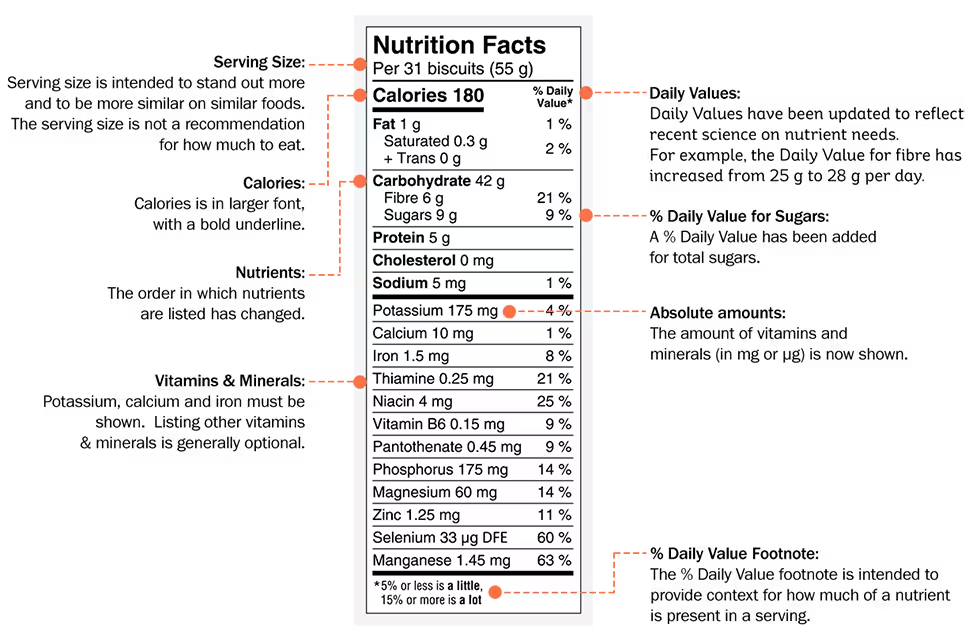Understanding Our New Food Labels
Health Canada has issued new regulations affecting the Nutrition Facts table and Ingredient List. At first glance, they may not seem much different than before. However, there are important changes we’d like to point out to you.
The new labels are intended to:
- provide more information about the nutrients and ingredients in food
- improve the legibility of food labels
- reflect recent science around nutrient needs
Overview of Changes to the Nutrition Facts Table
At Kashi, we’re here to help you navigate the changes so you can make informed food choices. By way of example, this Nutrition Facts Table for Kashi Cocoa Spice* cereal highlights the changes you need to know.

Questions & Answers About Our New Food Labels
Why has the nutrition labelling changed on your foods?
Health Canada has issued new nutrition labelling regulations, which include changes to the Nutrition Facts table and list of ingredients. These new regulations also require a change in serving size for some foods.
Why has serving size changed on some foods? Is the serving size a recommendation for how much I should eat?
Health Canada has issued new nutrition labelling regulations, which include changes to the Nutrition Facts table and list of ingredients. These new regulations also require a change in serving size for foods like cereal, crackers, toaster pastries and potato chips.<br>The new regulations are intended to create a more consistent serving size among similar foods in order to make comparisons easier. Serving size is not necessarily a recommendation for how much to eat. For example, under the new regulations all cereals and granolas will have a 1 cup serving size. One cup of granola is generally not an appropriate portion size.
Why is milk no longer listed on the Nutrition Facts table of your cereal?
While milk is still a popular accompaniment to cereal, we recognize that an increasing number of Canadians eat their cereal with a plant-based beverage or yogurt. Others prefer to snack on dry cereal. We have removed milk from the Nutrition Facts table in order to reflect these changes in consumption practices. Also, the new Nutrition Facts table includes more information than before and consumers may find it easier to read without the milk information.
Have the recipes of your foods changed or is it just the label?
For the majority of our foods, the new Nutrition Facts table and list of ingredients is for the same food, even if the nutrition is slightly different. This is due to the change in daily values, and may also reflect a change in serving size for foods like cereal, crackers, toaster pastries and potato chips.<br>However, there are some examples where we have also made food improvements, like reducing the sodium in Eggo* waffles. In these cases, both the food and the nutrition information have changed.
Why have the calories changed on some of your foods?
Health Canada has issued new nutrition labelling regulations, which include changes to the Nutrition Facts table and list of ingredients. These new regulations also require a change in serving size for some foods, which will affect the calorie value declared. Some of our recipes have also been updated to enable food improvement, which can also change the calories.
Why has sugar changed on some of your foods?
Health Canada has issued new nutrition labelling regulations, which include changes to the Nutrition Facts table and list of ingredients. These new regulations also require a change in serving size for some foods, which will affect the sugar value declared. Some of our recipes have also been updated to enable food improvement, which can also change the sugar value.
Why have the % Daily Values changed on your foods?
Health Canada has updated all daily values to reflect recent science around nutrient needs. For example, the daily value for fibre has increased from 25 grams to 28 grams per day. Because of this, you will see a reduction in the percent daily value for fibre even if the food has not changed.<br>The change also reflects a different serving size for foods like cereal, crackers, toaster pastries and potato chips.
Visit the Health Canada website for more information.